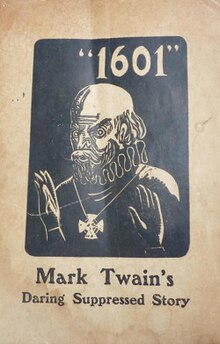[Date: 1601.] Conversation, as it was by the Social Fireside, in the Time of the Tudors.or simply1601is the title of a short risquésquibbyMark Twain,first published anonymously in 1880, and finally acknowledged by the author in 1906.[1]
 1882 edition | |
| Author | Mark Twain |
|---|---|
| Original title | Conversation, as it was by the Social Fireside, in the Time of the Tudors |
| Language | English |
Written as an extract from the diary of an "old man",Queen Elizabeth I's "cup-bearer", the pamphlet purports to record a conversation between Elizabeth and several famous writers of the day. The topics discussed are scatological, notably flatulence,flatulence humor,and sex.
1601was, according toEdward Wagenknecht,"the most famous piece of pornography inAmerican literature."[2]However, it was moreribaldrythan pornography; its content was more in the nature of irreverent and vulgar comedic shock than obscenity for sexual arousal.
Before the court decisions in the United States in 1959–1966 that legalized the publication ofLady Chatterley's Lover,Tropic of Cancer,andFanny Hill,the piece continued to be considered unprintable. It was circulated clandestinely in privately printed limited editions.
Content
editThe diarist describes a conversation in the presence of the queen between various famous Elizabethans during which one of the company passes gas:
- "In ye heat of ye talk it befel yt one did breake wind, yielding an exceding mightie and distresfull stink, whereat all did laugh full sore."
The Queen asks about the source and receives various replies. "Lady Alice" and "Lady Margery" both deny passing gas, the first saying:
- "Good your grace, an' I had room for such a thundergust within mine ancient bowels, 'tis not in reason I coulde discharge ye same and live to thank God for yt He did choose handmaid so humble whereby to shew his power. Nay, 'tis not I yt have broughte forth this rich o'ermastering fog, this fragrant gloom, so pray you seeke ye further."
Ben Jonson,Francis BaconandWilliam Shakespeare(referred to as 'Shaxpur') also deny having passed gas, though they have different opinions about the merits of flatulence. Bacon considers it a "great performance" beyond his abilities, and Shakespeare is astounded by its "firmament-clogging rottenness".Walter Raleighadmits to it, but confesses that it was not up to his usual standards, demonstrating his abilities by letting out an even louder one.
From there, the talk proceeds to manners and customs. Shakespeare tells a story about a prince with an enormous sexual appetite, taking ten "maidenheddes"a night followed by copious masturbation. Raleigh describes an American tribe, members of which have sex only once every seven years. The queen speaks to a young lady-in-waiting who comments on the growth of herpubic hair,on whichFrancis Beaumontcompliments her. The queen says thatFrancois Rabelaishad once told her about a man who had a "double pair" ofbollocks,which leads to a discussion on the correct spelling of the word.
Shakespeare then reads from his worksHenry IVandVenus and Adonis,which the diarist says she finds tedious. She then comments on the sexual misadventures of the people present, remarking that "when pricks were stiff and cunts not loathe to take ye stiffness out of them, who of this company was sinless". Alice and Margery were "whores from ye cradle", but now they are old and they spout religion. The characters then discuss the work ofCervantesand an up-and-coming young painter calledRubens.
The "diary" ends with a story told by Raleigh about a woman who avoided being raped by an "olde archbishoppe" by asking him to urinate in front of her, which rendered him impotent.
Publication history
editThe squib was originally written in 1876 for "a highly respectable, all-male writing group" as an exercise in the style of Rabelais.[3]It was first published in the "incredibly rare" Cleveland edition of 1880, which is believed to number only four copies.[4]The original edition was anonymous. While visitingWest Pointin 1881, Twain discovered that a man he met, Charles Erskine Scott Wood, had access to a private printing press. Twain asked Wood to print off a new edition of fifty copies (now known as the "West Point edition" ), which came out in 1882.[4]Twain acknowledged authorship in 1906.
The skit remained unprintable by mainstream publishers until the 1960s. It continued to be published by small private presses. Its characterization as "pornography" wassatirizedby Franklin J. Meine in the introduction to the 1939 edition. Another little-known edition[5]was printed from hand-set type by John Hecht in Chicago in 1951.
In 1978, the "Lazarus Edition" of 200 copies was published. It consisted of newly discovered pages of a private printing from the 20s with a new, wood-engraved portrait of Mark Twain, made byBarry Moser.
References
edit- ^Mark Twain's [Date 1601.] Conversation as It was by the Social Fireside in the Time of the Tudors: Embellished with an Illuminating Introduction by Franklin J. Meine.New York: Privately Printed forLyle Stuart.1962.RetrievedAugust 3,2017– via Internet Archive.
- ^John Daniel Stahl (1994).Mark Twain, culture and gender: envisioning America through Europe.University of Georgia Press.,p. 56"As Franklin Meine pointed out, Edward Wagenknecht misleadingly called it 'the most famous piece of pornography in American literature.'"
- ^Fisher Fishkin, Shelley,A Historical Guide to Mark Twain,Oxford University Press, New York, 2002, p.172
- ^abWecter, Dickson,Mark Twain in Three Moods: Three New Items of Twainiana,Friends of the Huntington Library, San Marino, CA., 1948, p.29
- ^Personal knowledge: My father was John Hecht and I knew Meine.
External links
edit- 1601atProject Gutenberg
- Another source for the full text of Mark Twain's1601
- 1601public domain audiobook atLibriVox